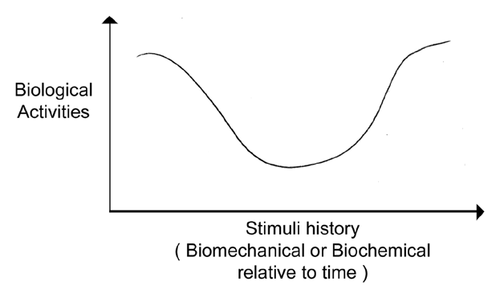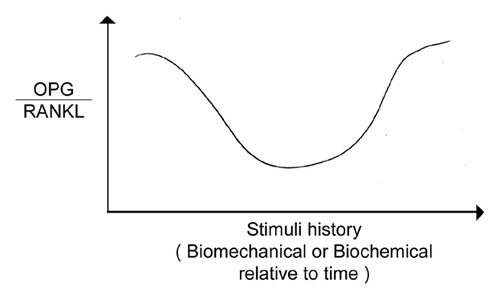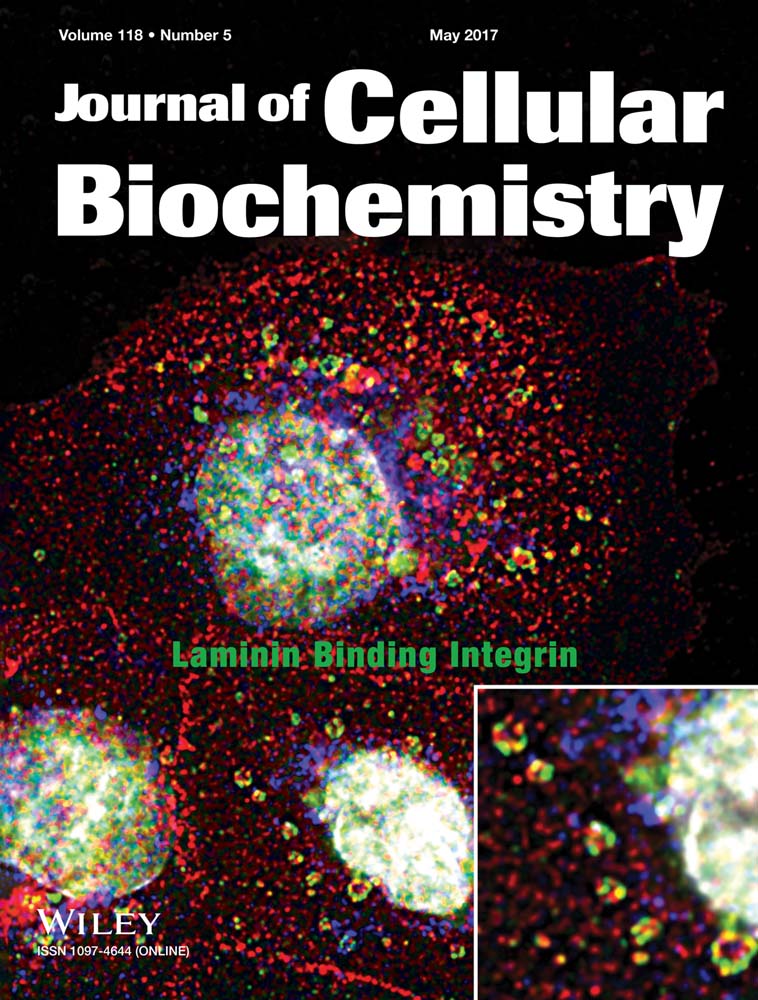The “Mechanostat” Principle and the Osteoprotegerin—OPG/RANKL/RANK System PART II. The Role of the Hypothalamic—Pituitary Axis
ABSTRACT
Recent literature provides us with the indication that the ratio of OPG/RANKL concentrations fluctuate in a non-linear (bell-shaped) mode, according to Frost's “mechanostat” theory, during the application of mechanical strain. A similar cellular signal transduction mechanism to mechanical loading, that may also regulate bone resorptive activities, has nowdays been proposed. Since the skeleton is considered to be an endocrine organ, as such, it may likewise be subject to hypothalamic control. This central regulatory system may continually modulate the adaptation of the bone homeostatic system to external challenges. The hypothalamic-pituitary-gonadal axis may play a role in the regulation of OPG/RANKL secretion. The “mechanostat” principle may well characterize the oscillatory properties of the signal transduction mechanism that controls hard tissue metabolism and includes biochemical apart from mechanical stimuli. J. Cell. Biochem. 118: 962–966, 2017. © 2016 Wiley Periodicals, Inc.
It has long been well understood that the functional coordination of the osteoprotegerin (OPG), receptor activator of NFkB ligand (RANKL), receptor activator of NFkB (RANK) proteinic system controls hard tissue metabolism by exerting biological effects on osteoblasts or osteoclasts. OPG inhibits osteoclast function and accelerates osteoclast apoptosis [Oshiro et al., 2002], while RANKL, together with the protein ligand macrophage colony stimulating factor (M-CSF) activates osteoclasts and induces bone resorption [Kartsogiannis et al., 1999]. Also, the relative concentrations of the OPG and RANKL regulate bone modeling, bone remodeling and root resorption on the compressed, and tensioned sides of a tooth, during tooth movement [Tyrovola et al., 2010, 2008], as well as physiological root resorption and bone modeling during tooth eruption [Harokopakis-Hajishengallis, 2007].
Recent literature provides us with the indication that the ratio of OPG/RANKL concentrations fluctuate in a non-linear (bell-shaped) mode, according to Frost's “mechanostat” theory, during the application of mechanical strain [Tyrovola, 2015] (Fig. 1). The change of the mechanical strain in relation to time (loading history) constitutes the triggering stimuli that influences the response of osteoblastic and osteoclastic cells and induces an oscillatory regulation of the OPG/RANKL proteinic system.

A similar cellular signal transduction mechanism to mechanical loading, that may also regulate bone resorptive activities, has nowdays been proposed. Neuropeptides (such as vasoactive intestinal peptide [VIP] or calcitonin gene related peptide [CGRP]), which are present in nerve fibers of bone tissues, have been suggested to potentially regulate bone remodelling and suppress bone resorptive activities through OPG/RANKL pathway, similar to mechanical loading [Yeong-Min, 2014]. Bone is richly innervated by sensory, sympathetic, and glutaminergic fibers. Substance P (SP), calcitonin gene related peptide (CGRP), vasointestinal peptide (VIP), neuropeptide Y (NPY), serotonin, glutamate, TH, and NE are among the neuronal products that have been detected in bone [Masi, 2012]. Bone formation has been shown to be neuronally regulated in distant bones of the skeleton, that were not loaded [Sample et al., 2008]. Thus, these neuropeptides may regulate bone resorptive activities in a similar manner to mechanical loading.
As the skeleton is considered to be an endocrine organ [Schwetz et al., 2012], as such, it may likewise be subject to hypothalamic control [Masi, 2012]. This central regulatory system may continually modulate the adaptation of the bone homeostatic system to external challenges. The hypothalamic-pituitary-gonadal axis may play a role in the regulation of OPG/RANKL secretion. Actually, OPG/RANKL/RANK proteins act as hormones in an endocrine regulatory system, which times physiological processes, among which bone modelling and remodelling are most crucial. And since the action of many hormones is characterized by pulsatility, circadian, and seasonal rhythmicity, the OPG/RANKL/RANK system may be characterized by oscillatory regulation properties.
In this review, an attempt will be made to provide information relative to the oscillatory regulation of the OPG/RANKL expression and it's connection to the central hypothalamic-pituitary-regulatory system. The “mechanostat” principle of Frost may well characterize the oscillatory properties of the signal transduction mechanism that controls hard tissue metabolism and includes biochemical apart from mechanical stimuli.
SEROTONIN AND THE OPG/RANKL/RANK SYSTEM
Serotonin displays a wide range of physiological functions depending on its site of synthesis and plays a multifunctional role in human homeostasis. First, it acts as a neurotransmitter in the central nervous system (brain derived serotonin [BDS]), which, in case it is altered, in central nervous system synapses, it is related to depression. It also influences cognitive and psychological function in higher centers of the brain (hypothalamus).
Second, it acts as a gut derived (gut derived serotonin-GDS) mediator of peristalsis, and gastrointestinal motility, an appetite mediator and a regulator of food intake, a regulator of circadian rhythmicity, and systemic blood pressure [Frishman et al., 1995], a determinant of platelet contraction and hemostasis and a regulator of energy modulation [Kawai and Rosen, 2010]. It also exerts effects on the immune system [Mossner and Lesch, 1998].
Recently, a serotonin-metabolic–CNS-skeletal connection has been recognised [Ducy and Karsently, 2010]. Osteoblast and osteoclast function seems to be the net effect of local, hormonal, or neuronal regulators, among which serotonin appears to have a very dynamic role. There is evidence that serotonin receptors are expressed in osteoblasts as well as in RANKL-induced osteoclasts [Bliziotes et al., 2006, 2001; Westbrock et al., 2001; Battaglino et al., 2004] and that serotonin has a role in the regulation of bone cell function. Gustafsson et al. [2006] investigated the effects of serotonin on human and murine osteoblast and osteoclast proliferation and differentiation, as well as on OPG and RANKL release. They found that serotonin receptors are expressed in human osteoclasts and tryptophan hydroxylase (Tph) (the principal enzyme of the conversion to serotonin) is expressed in both osteoclasts and osteoblasts. Serotonin enhanced proliferation of murine preosteoclasts but in a bell-shaped manner and in fact activated both NFkB and c FOS in a bell-shaped manner as well. NFkB activation was most pronounced at 0.01 µM, while at higher concentrations NFkB activation was absent. Serotonin enhanced the proliferation of primary osteoblasts and murine preosteoblasts in a bell-shaped dose-dependent manner. The authors acknowledge that in all experiments there appeared a biphasic increase in proliferation, with a maximum at about 1 µM, while higher concentrations led to inhibition. Finally, serotonin (1 µM) reduced the RANKL release with the most pronounced effect after 72 h of incubation, whereas it increased the OPG release after the same time. The above findings indicate that serotonin exerts effects on osteoblasts or osteoclasts and on the proteinic system OPG/RANKL/RANK that are concentration-dependent and bell-shaped.
Surprisingly, BDS has an antagonistic influence relative to gut derived serotonin (GDS) as regards to bone mass accrual [Ducy and Karsently, 2010; Li et al., 2015]. BDS acts as a neurotransmitter to exert a favorable effect on bone mass, by enhancing bone formation and reducing bone resorption, whereas gut derived serotonin inhibits bone formation. Therefore, serotonin provides a unique example of a molecule fulfilling opposite functions. What is important, however, is the fact that, although BDS constitutes only a small ratio of the total concentration of serotonin in the human body, the effects of BDS on bone mass are dominant and prevail over the effects that GDS exerts [Yadav et al., 2008]. This remarkable information gives undoudtly a priority to the study of BDS levels, relative to the osteoblast and osteoclast function and the OPG/RANKL expression.
It has been observed that BDS's levels cycle. Oscillating BDS's levels may provoke the oscillation of OPG/RANKL concentrations. Oscillating OPG/RANKL levels may be correlated to the oscillatory regulation of BDS and serotonin's metabolic product MEL, which in turn seems to be linked to the clock-directed autoregulatory loops of transcriptional regulators. It has long been well understood that the dynamic properties of transcriptional regulators constitute an essential link in the relay of hormonal, neuronal or local information [Foulkes et al., 1996; Ducy and Karsently, 2010; Kode et al., 2012].
For example, it has been reported that transcription factor c AMP-responsive element modulator (CREM) may be a key player in shaping oscillatory hormone synthesis in the pineal gland (where it displays a striking clock driven circadian fluctuation) [Foulkes et al., 1996]. The CREM feedback loop transduces a rhythmic clock directed signal into rhythmic hormone synthesis. This oscillating transcriptional control mechanism includes phosphorylation, and dephosphorylation, as well as negative autoregulation of the promoter ICER, thus generating a feedback loop. And autoregulatory loops seem to be a common theme in the molecular regulation of circadian rhythms.
BDS, through serotonergic neurons of the dorsal raphe (DR) signal to ventromedialhypothalamic neurons (VMH) via the Htr2c receptor and the tone of the sympathetic system. The change of the sympathetic tone finally acts on the molecular clock gene/cyclin D1 (CycD1) cascade and the PKA/ATF4-dependent pathway of the osteoblast in order for RANKL to be decreased. As it seems, OPG/RANKL ratio may be secondary to the tone of the sympathetic signalling, exerted in osteoblasts [Yadav et al., 2009; Ducy and Karsently, 2010].
MELATONIN AND THE OPG/RANKL/RANK SYSTEM
Melatonin (MEL) is synthesized via the serotonin pathway in the pineal gland. Serotonin is converted to N-acetyl-5-hydroxytryptamine (with the aid of the enzyme N-acetyltransferase [NAT], which is activated in darkness) and finally is converted to Melatonin (with the aid of the enzyme 5-hydroxyindole-0-methyltransferase). Darkness stimulates the synthesis of Melatonin, while light inhibits it [Amstrup et al., 2013; Michalowska et al., 2015].
As previously documented, the striking clock driven circadian fluctuation of CREM expression in the pineal gland, as well as oscillating levels and feedback loop of the promoter ICER may be tightly related to the shaping of oscillatory hormone in the pineal gland. It has been reported that oscillating ICER levels correlate to fluctuations in the expression of the pineal hormone Melatonin, which in turn regulates the hypothalamic-pituitary axis. In addition, oscillations in NAT levels may regulate the circadian synthesis of Melatonin [Foulkes et al., 1996].
MEL exerts anabolic and antiresorptive effects on bone. Melatonin receptors are reported to be expressed on mesenchymal cells (MSCs), on preosteoblasts, on osteoblasts, as well as on osteoclasts. Through binding to melatonin receptors on MSCs, melatonin seems to increase differentiation of these cells to osteoblasts and through binding to melatonin receptors on pre-osteoblasts and osteoblasts it seems to stimulate proliferation and differentiation of these cells and to increase the synthesis of OPG. Finally, melatonin may inhibit proliferation and differentiation of osteoclasts and decrease the synthesis of RANKL [Koyama et al., 2002; Amstrup et al., 2013; Wang et al., 2013; Maria and Witt-Enderby, 2014; Michalowska et al., 2015].
Koyama et al. [2002] investigated the effect of melatonin on the expression of RANKL and OPG in mouse MC3T3-E1 osteoblastic cells. They demonstrated that pharmacological doses of MEL decreased in vitro expression of RANKL in a dose dependent manner. In addition, they increased OPG expression (m RNA levels as well as protein levels) in a dose dependent manner, in mouse MC3T3-E1 osteoblastic cells, proving that melatonin participates in OPG/RANKL mediated skeletal effects. Histing et al. [2012] agrees with these findings and support the decrease of RANKL expression and osteoclast activation by melatonin.
Previous studies indicated that bone turnover exhibits a circadian rhythm [Sairanen et al., 1994; Ledger et al., 1995; Greenspan et al., 1997]. Recently it has been demonstrated that melatonin may have a role in reduced bone volume in anorectic patients, because of abnormalities in nocturnal secretion and cosequent modulation of the OPG/RANKL ratio [Ostrowska et al., 2010]. Increased amplitude between the nocturnal and morning levels of MEL may influence the OPG/RANKL balance and affect the bone tissue in girls with anorexia nervosa, apart from abnormalities in the formation and release of various other hormones. The amplitude values between the nocturnal and morning levels of MEL showed a significant negative correlation with the OPG/RANKL ratio and these amplitude values proved to be significant predictors of the OPG/RANKL ratio [Ostrowska et al., 2013]. The authors conclude that alterations in OPG and s RANKL levels observed in girls with anorexia nervosa are associated with changes in nocturnal melatonin secretion and the circadian rhythm of MEL.
Taken together all the aforementioned information indicate that the oscillating levels of the hormone melatonin may exert oscillating effects and regulation upon OPG/RANKL secretion.
TSH, FSH, LH, ACTH, PRL, AND THE OPG/RANKL/RANK SYSTEM
Ostrowska et al. [2013] attempted to investigate whether hormones of the pituitary-ovarian, -thyroid, and -adrenocortical axes may mediate and affect the balance of the OPG/RANKL/RANK system. They found that a correlation between LH, FSH, E2, FT3, cortisol, and the OPG/s RANKL ratio existed. Changes in the secretion of hormones of the pituitary-ovarian-thyroid and adrenocortical axes correlated with OPG/s RANKL or OPG/s RANKL ratio and also with melatonin secretion. The authors suspect that the above hormones, which relate to hormone melatonin, may influence the OPG/RANKL ratio, not only directly but also through melatonin mediation.
In patients with overt hypothyroidism, plasma OPG levels increase significantly. Replacement therapy with levothyroxine (L-T4) normalizes thyroid function and decreases OPG plasma levels close to normal, indicating the important regulatory role of this hormone relative to OPG/RANKL system [Guang-Da et al., 2005; Mikosch et al., 2006]. OPG has been found to be increased not only in hypothyroidism but also to hyperthyroidism [Shinkov et al., 2014] and to change with the thyroid function. OPG levels demonstrate a trend toward lower values in the euthyroid patients compared to those with elevated or suppressed TSH. Furthermore, TSH receptors seem to be present both in osteoclast and osteoblast. TSH may modulate bone remodelling independent of thyroid hormones. Acute TSH administration in thyroidectomised patients, who are on l-thyroxin therapy, increases osteoblastic activity, increases serum RANKL, and changes OPG/RANKL balance [Martini et al., 2008].

Finally, as regards to prolactin (PRL), Seriwatanachai et al. [2008] demonstrated that the concentration of PRL acts directly on bone to regulate bone turnover. Hyperprolactinemia stimulated bone turnover by changing the OPG/RANKL balance and shifting it towards enhanced bone resorption. Levels of PRL may directly regulate the osteoblast functions and the presence of PRL receptors in osteoblasts, implicate osteoblasts as a direct target of PRL.

MOOD AND BEHAVIOR AND THE OPG/RANKL/RANK SYSTEM
Serotonin and serotonergic neurotransmission for many years has been implicated to depression and other relative systemic disorders, which may be triggered by different factors but ultimately target serotonin in valnerable individuals. In addition, melatonin and it's amplitude values have been related to anorexia nervosa in young females. Conclusively, psychological status may play a crucial role in the modulation of bone cell function and regulation of bone turnover and the OPG/RANKL/RANK system. Psycological parameters may alter serotonin and melatonin expression and induce a shift of the OPG/RANKL/RANK system and the ratio OPG/RANKL towards an unbalanced status.
CONCLUSIONS
- - The “mechanostat” principle of Frost may well characterize and describe the oscillatory properties of the signal transduction mechanism, that controls hard tissue metabolism and includes biochemical apart from biomechanical stimuli (Fig. 2).
- - The central hypothalamic-pituitary regulatory system, via it's relative hormones, seems to control OPG/RANKL/RANK system function.
- - Pulsatility and circadian rhythmicity of the aforementioned hormones may induce an oscillatory fluctuation of the OPG/RANKL ratio (Fig. 3).
- - Psycological characteristics may provoke a shift of the OPG/RANKL ratio towards an unbalanced or a balanced status




